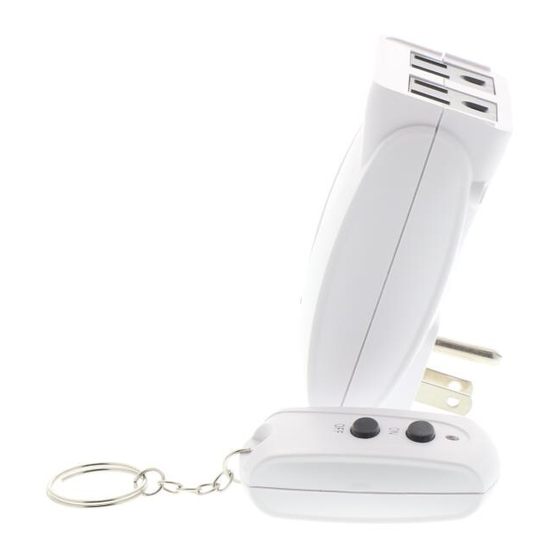
Publicidad
Idiomas disponibles
Idiomas disponibles
Enlaces rápidos
MODEL #UTTNRC21
REMOTE CONTROL
OUTLETS
Call customer service at 1-866-994-4148,
8 a.m. - 6 p.m., EST, Monday - Thursday,
8 a.m. - 5 p.m., EST, Friday.
OPERATING INSTRUCTIONS
1. Remove the plastic battery tab
from the battery compartment
in the back of the remote
control to activate the
pre-installed battery.
2. Plug the receiver into a
grounded, 3-wire indoor outlet,
making sure there is power to
the outlet the receiver is
plugged into.
3. Plug the lights or devices to
be controlled into the receiver.
4. Press the ON/OFF buttons on
the remote control to turn the
lights or devices on or off. The
red indicator light on the
receiver is lit when the unit is
powered on.
AB141044
ITEM #0141479
HELPFUL TIPS
• Make sure the receiver is plugged into a working AC outlet.
• Make sure the receiver and connected equipment are on.
• Make sure the remote control ON button is pushed.
• Make sure the battery in the remote control is still
functioning.
BATTERY REPLACEMENT
Use your finger to slide out the battery holder on the left
bottom corner of the remote. Remove the spent battery
and insert a new CR2032, 3V button-cell battery with the
"+" polarity mark facing up. Slide the battery holder back
inside. Dispose of the old battery in compliance with all
applicable laws. Contact your local solid waste authority
for detailed information. Non-rechargeable batteries are
not to be recharged.
1
WARNING: DO NOT DISPOSE OF BATTERIES IN
FIRE. BATTERIES MAY EXPLODE OR LEAK.
BATTERY SUPPLIER: Changzhou Rihui Battery Co., Ltd.
FCC REGULATORY STATEMENT
This device complies with part 15 of the FCC rules.
Operation is subject to the following two conditions:
2
1. This device may not cause harmful interference, and
2. This device must accept any interference received,
including interference that may cause undesired
operation.
Notes: This equipment has been tested and found to comply
with the limits for a Class B digital device, pursuant to Part
15 of the FCC Rules. These limits are designed to provide
reasonable protection against harmful interference in a
residential installation. This equipment generates, uses and
3
can radiate radio frequency energy and, if not installed and
used in accordance with the instructions, may cause
harmful interference to radio communications. However,
there is no guarantee that interference will not occur in a
particular installation. If this equipment does cause harmful
interference to radio or television reception, which can be
determined by turning the equipment off and on, the user is
encouraged to try to correct the interference by one or more
of the following measures:
4
1. Reorient or relocate the receiving antenna.
2. Increase the separation between the equipment and
receiver.
3. Connect the equipment into an outlet on a circuit different
from that to which the receiver is connected.
4. Consult the dealer or an experienced radio/TV technician
for help.
TROUBLESHOOTING
PROBLEM POSSIBLE
CORRECTIVE
CAUSE
ACTION
Connected
Ensure the connected
Equipment
lights are not
lights are functional by
plugged
in "ON"
plugging them directly
into the
position, they
into the outlet. Be sure
receiver is
are not
the connected lights
not
functioning,
are in the "ON"
working.
remote is
position if they have
not receiving
their own switch.
power or
Make sure the outlet
remote control
the receiver is
ON button is
plugged into is active.
not pushed.
Make sure the remote
control ON button is
pushed. Replace the
CR2032, 3V battery in
the remote control.
SAFETY INFORMATION
This is a "GROUNDED" device. The male
plug contains a ground pin and is only
intended for use with a three-pronged
grounded outlet.
This device is for use with a 125 V AC power source.
125 V AC / 60 Hz
Do not attach a device that exceeds the unit ratings:
15 A / 1,875 W Resistive (General Purpose)
5 A / 625 W Tungsten (Incandescent)
WARNING: CHOKING HAZARD – Small
!
Parts. Not for children under 3 years.
IC REGULATORY STATEMENT
Under Industry Canada regulations, this radio transmitter
may only operate using an antenna of a type and
maximum (or lesser) gain approved for the transmitter by
Industry Canada. To reduce potential radio interference to
other users, the antenna type and its gain should be so
chosen that the equivalent isotropically radiated power
(e.i.r.p.) is not more than that necessary for successful
communication.
This
device
complies
with
licence-exempt RSS standard(s). Operation is subject to
the following two conditions: (1) this device may not cause
interference, and (2) this device must accept any
interference, including interference that may cause
undesired operation of the device.
Industry
Canada
Printed in China
Publicidad

Resumen de contenidos para Utilitech UTTNRC21
- Página 1 ITEM #0141479 HELPFUL TIPS TROUBLESHOOTING • Make sure the receiver is plugged into a working AC outlet. MODEL #UTTNRC21 PROBLEM POSSIBLE CORRECTIVE • Make sure the receiver and connected equipment are on. CAUSE ACTION REMOTE CONTROL • Make sure the remote control ON button is pushed.
- Página 2 REEMPLAZO DE LAS BATERÍAS SOLUCIÓN DE PROBLEMAS ARTÍCULO #0141479 MODELO #UTTNRC21 Use el dedo para deslizar el soporte de la batería en la PROBLEMA CAUSA ACCIÓN esquina inferior derecha del control remoto. Retire la batería POSIBLE CORRECTIVA SALIDAS PARA usada e inserte una batería de botón CR2032 de 3 voltios...
